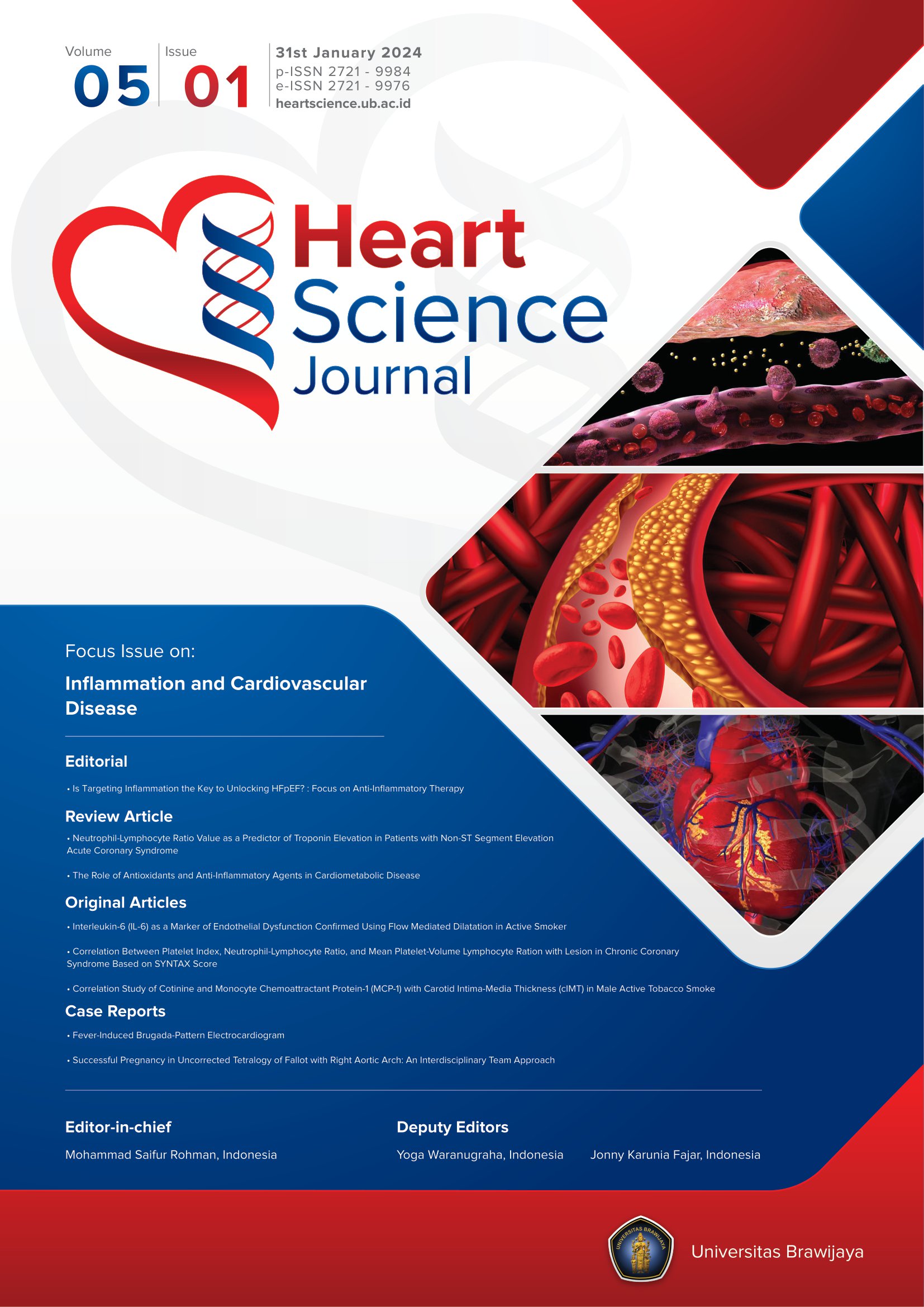The Effect of Add-on Garcinia mangostana L. Extract on Endothelial Dysfunction in Type 2 Diabetes Mellitus Subjects with High Risk Framingham Score: A Cohort Study
Abstract
Background : Garcinia mangostana L. has been extensively used for years as antioxidant and anti-inflammation. However, its role in the context of endothelial disease was lacking.
Objectives : To assess the effect of add-on G. mangostana L. extracts on endothelial dysfunction in type 2 diabetes subjects with high-risk Framingham score, compared to placebo.
Methods : This was a prospective cohort study conducted in type 2 diabetes subjects with high-risk Framingham score. Subjects were randomized into two groups. The first group received 2,520 mg/day of G. mangostana L. extract. The second group was given a placebo for 90 days. The outcome measure of our study was the levels of endothelial progenitor cell (EPC), circulating endothelial cell (CEC), nitric oxide (NO), tumor necrosis factor-α (TNF-α), interleukin-1 (IL-1), IL-6, hemoglobin A1c (HbA1c), high-sensitivity C-reactive protein (hs-CRP), malondialdehyde (MDA), Superoxide dismutase (SOD) and fasting blood glucose. Multiple linear regression was used to determine the correlation and effect estimate.
Results: A total of 49 patients were included in our study. Of those, elevated levels of EPC and SOD were observed in treatment group compared to placebo. On the other hand, the level of CEC, IL-1, Il-6, NO, MDA, TNF-α, fasting blood glucose and HbA1c was found significantly lower than placebo.
Conclusion: Garcinia mangostana L. extract is associated with an increased levels of EPC and SOD, and it is also correlated with a decreased levels of CEC, IL-1, Il-6, NO, MDA, TNF-α, fasting blood glucose and HbA1c.
Keywords
Full Text:
PDFReferences
Vandenbroucke JP, Von Elm E, Altman DG, et al. Strengthening the Reporting of Observational Studies in Epidemiology (STROBE): explanation and elaboration. Ann Intern Med 2007;147(8):W-163.
Levey AS, Coresh J, Bolton K, et al. K/DOQI clinical practice guidelines for chronic kidney disease: Evaluation, classification, and stratification. Am. J. Kidney Dis. 2002;39(2 SUPPL. 1).
Wilson PWF, D’Agostino RB, Levy D, Belanger AM, Silbershatz H, Kannel WB. Prediction of coronary heart disease using risk factor categories. Circulation [Internet] 1998 [cited 2020 Apr 2];97(18):1837–47. Available from: https://www.ahajournals.org/doi/10.1161/01.CIR.97.18.1837
Wihastuti TA, Sargowo D, Tjokroprawiro A, Permatasari N, Widodo MA, Soeharto S. Vasa vasorum anti-angiogenesis through H2O2, HIF-1α, NF-κB, and iNOS inhibition by mangosteen pericarp ethanolic extract (Garcinia mangostana Linn) in hypercholesterol-diet-given Rattus norvegicus Wistar strain. Vasc Health Risk Manag 2014;10:523–31.
Wihastuti TA, Sargowo D. The Comparation of Activation Nuclear Factor Kappa Beta (NFkB) at Rattus Novergicus Strain Wistar Induced by Various Duration High Fat Diet. World Acad Sci Eng Technol [Internet] 2012 [cited 2020 Apr 2];6(9):216–8. Available from: https://publications.waset.org/8466/the-comparation-of-activation-nuclear-factor-kappa-beta-nfkb-at-rattus-novergicus-strain-wistar-induced-by-various-duration-high-fat-diet-hfd
Wihastuti TA, Widodo MA, Heriansyah T, Sari NAK. Study of the inhibition effect of ethanolic extract of mangosteen pericarp on atherogenesis in hypercholesterolemic rat. Asian Pacific J Trop Dis 2015;5(10):830–4.
Bonetti PO, Lerman LO, Lerman A. Endothelial dysfunction: A marker of atherosclerotic risk. Arterioscler. Thromb. Vasc. Biol. 2003;23(2):168–75.
Avogaro A, Albiero M, Menegazzo L, De Kreutzenberg S, Fadini GP. Endothelial dysfunction in diabetes: The role of reparatory mechanisms. Diabetes Care. 2011;34(SUPPL. 2):S285.
Sen S, McDonald SP, Coates PTH, Bonder CS. Endothelial progenitor cells: Novel biomarker and promising cell therapy for cardiovascular disease [Internet]. Clin. Sci. 2011 [cited 2020 Apr 2];120(7):263–83. Available from: https://portlandpress.com/clinsci/article/120/7/263/68872/Endothelial-progenitor-cells-novel-biomarker-and
Alexandru N, Titorencu I, Frunzã S, Weiss E, Bãdilã E, Georgescu A. Endothelial Progenitor Cell Dysfunction in the Pathogenesis of Vascular Complications of Diabetes. In: Mechanisms of Vascular Defects in Diabetes Mellitus. Springer International Publishing; 2017. p. 159–208.
Jung HA, Su BN, Keller WJ, Mehta RG, Kinghorn AD. Antioxidant xanthones from the pericarp of Garcinia mangostana (Mangosteen). J Agric Food Chem 2006;54(6):2077–82.
Kartha CC, Ramachandran S, Pillai R. Mechanisms of Vascular Defects in Diabetes Mellitus. Springer; 2017.
Yu C-G, Zhang N, Yuan S-S, et al. Endothelial Progenitor Cells in Diabetic Microvascular Complications: Friends or Foes? Stem Cells Int [Internet] 2016;2016:1803989. Available from: https://doi.org/10.1155/2016/1803989
Abdallah HM, El-Bassossy H, Mohamed GA, El-Halawany AM, Alshali KZ, Banjar ZM. Phenolics from Garcinia mangostana inhibit Advanced Glycation Endproducts formation: Effect on Amadori products, cross-linked structures and protein thiols. Molecules [Internet] 2016 [cited 2020 Apr 2];21(2):251. Available from: http://www.ncbi.nlm.nih.gov/pubmed/26907243
Ibrahim SRM, Mohamed GA, Khayat MT, Ahmed S, Abo-Haded H, Alshali KZ. Mangostanaxanthone VIIII, a new xanthone from Garcinia mangostana pericarps, α-amylase inhibitory activity, and molecular docking studies. Brazilian J Pharmacogn [Internet] 2019 [cited 2020 Apr 2];29(2):206–12. Available from: https://linkinghub.elsevier.com/retrieve/pii/S0102695X18307075
Abdallah HM, El-Bassossy HM, Mohamed GA, El-Halawany AM, Alshali KZ, Banjar ZM. Mangostanaxanthones III and IV: advanced glycation end-product inhibitors from the pericarp of Garcinia mangostana. J Nat Med [Internet] 2017 [cited 2020 Apr 2];71(1):216–26. Available from: http://www.ncbi.nlm.nih.gov/pubmed/27738860
Jindarat S. Xanthones from mangosteen (Garcinia mangostana): Multi-targeting pharmacological properties. J Med Assoc Thail [Internet] 2014 [cited 2020 Apr 2];97:S196–201. Available from: https://www.researchgate.net/publication/269771930_Xanthones_from_mangosteen_Garcinia_mangostana_Multi-targeting_pharmacological_properties
McClung JA, Naseer N, Saleem M, et al. Circulating endothelial cells are elevated in patients with type 2 diabetes mellitus independently of HbA1c. Diabetologia [Internet] 2005 [cited 2020 Apr 2];48(2):345–50. Available from: http://www.ncbi.nlm.nih.gov/pubmed/15660261
Aragona CO, Imbalzano E, Mamone F, et al. Endothelial progenitor cells for diagnosis and prognosis in cardiovascular disease. Stem Cells Int. 2016;2016.
Fadini GP, Sartore S, Agostini C, Avogaro A. Significance of endothelial progenitor cells in subjects with diabetes [Internet]. Diabetes Care. 2007 [cited 2020 Apr 2];30(5):1305–13. Available from: http://www.ncbi.nlm.nih.gov/pubmed/17277037
DOI: https://doi.org/10.21776/ub.hsj.2020.001.01.5
Refbacks
- There are currently no refbacks.
Copyright (c) 2020 Heart Science Journal
License URL: https://creativecommons.org/licenses/by/4.0/









